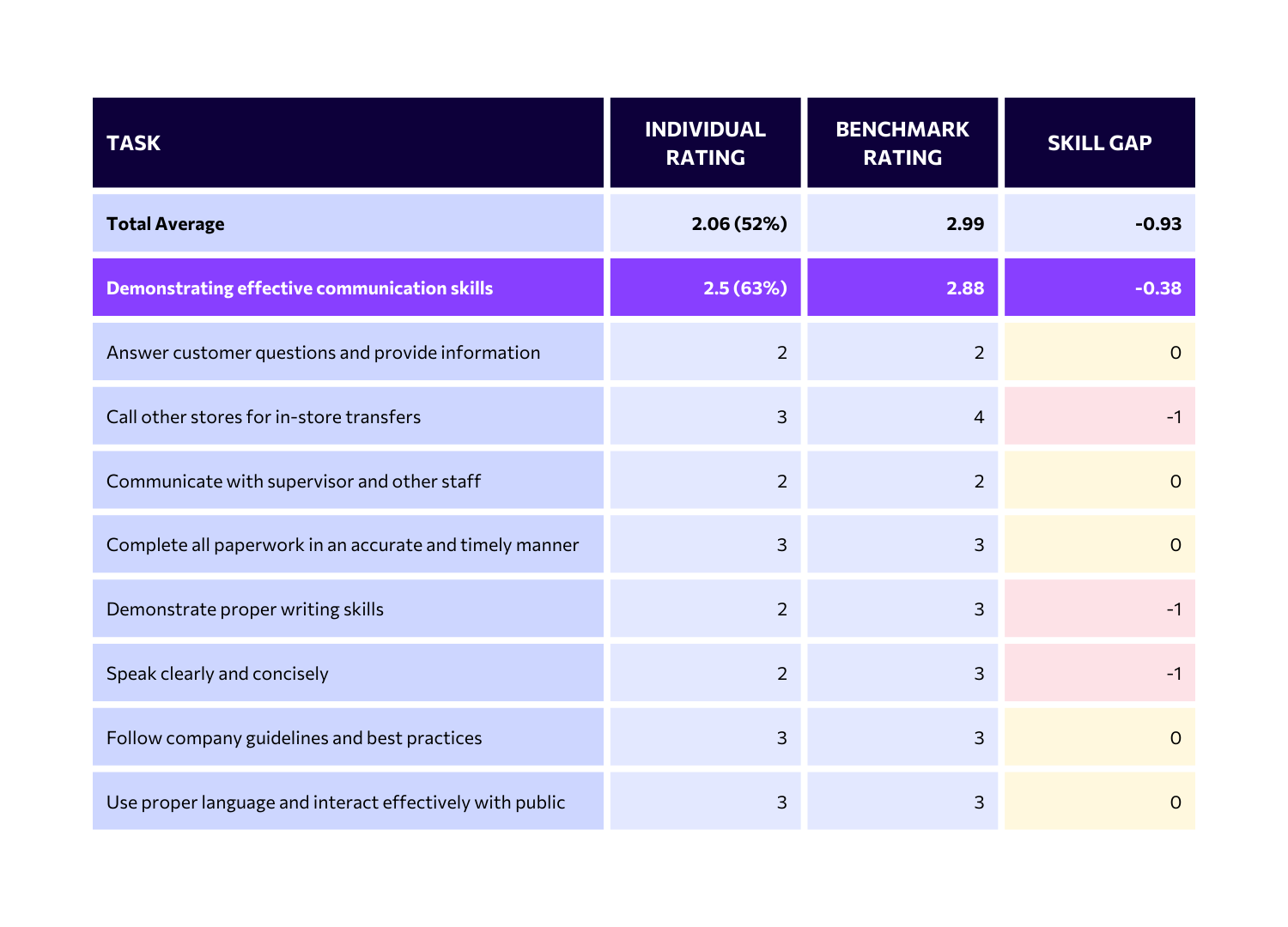Skills Gap Analysis: What It Is, How It Works & How To Conduct
TABLE OF CONTENTS
Industries worldwide are struggling to find people with the right skills. There are many causes for this skills gap, from a lack of education to changes in how we work and technological innovations. They make it difficult to build a productive and agile workforce, able to respond swiftly to market changes.
Many organizations choose to hire new talent in an attempt to fill skills gaps in their workforce, but competition for skills is at an all-time high. Providing upskilling and training opportunities for your existing employees instead may be the more cost-effective solution.
The first step, however, is to understand the severity of your skills gap. Read on to find out what a skills gap analysis is, and how to conduct one within your company in order to maximize productivity and training ROI.
Quick navigation:
- What is a skills gap analysis?
- How does a skills gap analysis work?
- Benefits of a skills gap analysis
- How to conduct a skills gap analysis
What is a skills gap analysis?
It's difficult for educational institutions to deliver graduates with all the necessary skills due to the pace of change across industries. Changes in technology can also create gaps in a workforce’s current skill set. This produces a mismatch between a company's skill requirements and the skills that are actually available, aka the skills gap.
A skills gap analysis is used to identify which skills are needed but currently unavailable within an organization. Ascertaining what skills you need now is part of it, but the real value comes from knowing what skills you will need in the future. This helps businesses to build training programs to upskill their current workforce, and guides decisions on hiring priorities.
Businesses can also apply their skills gap findings to resource management. Alternatively, it may reveal a need for changes in the HR department. Whatever the results of your analysis, you will then need to take action. A skills gap analysis provides insights that allow creative thinking around the skills gap problem.
How does a skills gap analysis work?
A skills gap analysis is something you should undertake regularly - annually at the very least. Whenever there is a major change in the business is usually the best time to measure your current skills gap, and how you can narrow it.
As with any analysis tool, the data you insert determines the quality of the insights you’re able to glean from it. This means that organizations that value data will have a head start. If you don’t already, make keeping records around skills and training a priority.
There are two approaches to a skills gap analysis that you’ll need to know. They’re both conducted similarly, but are employed for different purposes.
Talent gap analysis
A talent gap analysis is used to inform your recruitment decisions. It tells you which skills new candidates will need in the coming years.
Employee skills analysis
The purpose of an employee skills analysis is to assess how your current workforce’s skill set matches your needs going forward. To sustain growth and keep up with technological advances, employees need up-to-date training. This sort of analysis allows for informed decision-making around learning and development.
The benefits of completing a skills gap analysis
You might think you already know what your employees are capable of. But a skills gap analysis is a more concrete method of confirming who can do what. It provides deeper insight into the skills you have at your disposal, and helps you determine the extra skill sets you’ll need as the business grows. If the analysis highlights gaps in specific areas, you’ll know to prioritize those in your recruitment.
For your existing employees, it will also reveal opportunities for training and development, helping them develop extra skills and progress their careers. 94% of employees would stay longer at a company which invested in their learning, so this is beneficial for employee satisfaction and retention.
A skills gap analysis also assists you with effective workforce planning, as it shows you how best to deploy available skills and assign the right tasks to the right people. This is another great way to boost employee motivation and give your company a competitive advantage.

How to conduct a skills gap analysis
How exactly you conduct your skills gap analysis will depend on several factors - the size of your company and specific team, and your growth forecasts. The guide provided below will help you get started.
1. Make a plan
As with any project, you have to plan before undertaking your analysis. Start by choosing who will run it. Generally, companies will use their HR department to oversee skills gap analysis. They will be able to adapt the strategy to your specific business needs, and set benchmarks in order to compare the results. The analysis will need to be conducted on two levels: individually, and for each team. On an individual level, you will want to ascertain the required skills for each role. Then you will compare the skill sets of the employees in those roles.
The analysis will need to be conducted on two levels: individually, and for each team. On an individual level, you will want to ascertain the required skills for each role. Then you will compare the skill sets of the employees in those roles.
On a team level, it’s the same process, but you’re taking in the wider skill set of an entire group of employees. This may reveal opportunities to fill skills gaps through cross-functional collaboration. This is when skills in one department can meet the needs of another.
Next, you’ll want to decide how you will gather the relevant data. You could talk to team leads to garner the information, refer to training records to reveal skills learned in-house, or even conduct employee interviews. Talking to employees may reveal skills unknown to the company up until now, and can provide insights into other areas such as employee productivity.
2. Understand your needs
In order to figure out which skills your company needs, you first need to ensure you have a clear idea of what you’re trying to achieve. Think about where the business is going and how employee skills can impact that, starting with these simple questions:
- What is it that your company does, and how do you do it?
- Are there any upcoming projects that require skills that your organization is lacking?
- Do you plan on introducing new technology to the workplace?
- Have you got vacancies that need filling?
- Is there too much overlap with available skills between employees and teams?
- Where is the business headed in the short-to-medium term?
- Where is the business headed in five-to-ten years?
3. Keep an eye on the future
The way we work is constantly changing. It’s impacted by technological changes, social attitudes, and responses to events such as the pandemic. As such, always consider how future changes can influence your skill needs.
As AI continues to develop, it is allowing the automation of more and more tasks. There are likely to be skills that your teams currently possess that will be redundant in the future. Conversely, new technologies create a demand for new skills.
Which emerging technologies will your organization benefit from? You’ll need people with the appropriate skills to use them. Factor this in when deciding what actions you’ll take as a result of your analysis.
/unsplash-image-5QgIuuBxKwM-4.jpg?width=777&name=unsplash-image-5QgIuuBxKwM-4.jpg)
4. Make an inventory of available skills and identify gaps
To discover where the gaps lie, you’ll need to know which skills are currently at your disposal. Create a skills inventory to find out how proficient and productive your employees are, as this may reveal a need for extra training. Here are some ways in which you can find this information:
- Conduct employee interviews. This can be part of annual performance reviews.
- Have conversations with team leaders. Fold skills gap analysis into departmental review meetings.
- Refer to training records. Keep training records along with personnel files.
- Examine performance at the individual, team, and company levels.
- Test your people using skill assessments.
You will now be able to compare skills available to the organization against what you can actually access. On a team or company level, this may influence hiring decisions. When it comes to individuals, it can reveal training opportunities.
5. Decide on your actions
By conducting this analysis, you will have identified gaps in available skills. Now you’ll need to work out how to close those gaps. .png?width=1500&name=Skills%20gap%20analysis%20(1).png) In the case of a complete absence of required skills, you’ll need to look at your hiring practices. It may be possible to upskill current employees, but recruiting new talent may be your best option. When looking for potential employees on LinkedIn and other recruitment portals, ensure that job listings make it clear what skills are required and to what level of proficiency. You may also need to make changes to your onboarding process.
In the case of a complete absence of required skills, you’ll need to look at your hiring practices. It may be possible to upskill current employees, but recruiting new talent may be your best option. When looking for potential employees on LinkedIn and other recruitment portals, ensure that job listings make it clear what skills are required and to what level of proficiency. You may also need to make changes to your onboarding process.
Your analysis may reveal that some skills are seldom required but are essential from time to time. In these cases, it may be a good idea to develop a contingency workforce. This is when you rely on freelancers and contractors to come in for certain projects. It offers your organization the flexibility to call on certain skills when required.
If your skills gap analysis finds that proficiency is lacking, then training is required. You may have the resources to upskill internally, but there are many third-party virtual training programs you could use. Another option is to establish a mentorship scheme, i.e. pairing your most experienced team members up with those needing to sharpen their skills.
With an eye on the future, you may find there will be team members whose skills have become redundant. Don’t waste their talents unnecessarily; reskill them through training when possible. It may be easier than trying to hire new talent in a competitive employment market. Create a continuous learning culture so your employees can keep up with new working trends.
Another way to prepare for the future is through internships and apprenticeships. This allows you to tap into new talent with emerging skills and instill the next generation with the right values. Your organization will reap the rewards if you invest in young talent.
Close the gap
Competition for skills is high. Your business can thrive by having the right skills in the right place. A skills gap analysis is the tool for the job. It will help you boost employee productivity. Knowledge is power. So, understanding when your organization lacks skills empowers you to solve the problem through action—whether that’s for right now or for the future.

Jenna Bunnell - Senior Content Marketing Manager at Dialpad
Jenna Bunnell is the Senior Manager for Content Marketing at Dialpad, an AI-incorporated cloud-hosted unified communications system that provides valuable call details for business owners and sales representatives. She is driven and passionate about communicating a brand’s design sensibility and visualizing how content can be presented in creative and comprehensive ways. Jenna has also written interesting articles for Recruitee and nTask. Check out her LinkedIn profile.
Join 10,000+ frontline leaders
Subscribe to ‘Training the Frontline’ and get weekly insights sent straight to your inbox.


